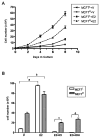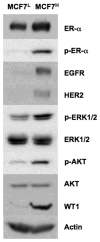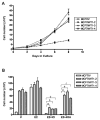The Wilms' tumor suppressor WT1 induces estrogen-independent growth and anti-estrogen insensitivity in ER-positive breast cancer MCF7 cells
- PMID: 20204298
- PMCID: PMC2837513
- DOI: 10.3892/or_00000739
The Wilms' tumor suppressor WT1 induces estrogen-independent growth and anti-estrogen insensitivity in ER-positive breast cancer MCF7 cells
Abstract
A switch from estrogen-dependent to estrogen-independent growth is a critical step in malignant progression of breast cancer and is a major problem in endocrine therapy. However, the molecular mechanisms underlying this switch remain poorly understood. The Wilms' tumor suppressor gene, wt1, encodes a zinc finger protein WT1 that functions as a transcription regulator. High levels of the WT1 expression have been associated with malignancy of breast cancer. The goal of this study was to investigate the function of WT1 in malignant progression of breast cancer. We found that the high passage ER-positive breast cancer MCF7H cells expressed EGFR, HER2 and WT1 at higher levels compared to the low passage MCF7L cells. MCF7H cells responded weakly to estrogen stimulation, grew rapidly in the absence of estrogen and were insensitive to anti-estrogens such as ICI 182,780 and 4-hydroxy-tamoxifen (4OH-TAM). We also established stable cell lines from the low passage MCF7L cells to constitutively express exogenous WT1 and found elevated levels of EGFR and HER2 expression, estrogen-independent growth and anti-estrogen insensitivity in WT1-transfected MCF7L cells. These results suggested WT1 promotes estrogen-independent growth and anti-estrogen resistance in ER-positive breast cancer cells presumably through activation of the signaling pathways mediated by the members of EGFR family.
Figures






Similar articles
-
The Wilms' tumor suppressor WT1 regulates expression of members of the epidermal growth factor receptor (EGFR) and estrogen receptor in acquired tamoxifen resistance.Anticancer Res. 2010 Sep;30(9):3637-42. Anticancer Res. 2010. PMID: 20944147 Free PMC article.
-
Correlation of Wilms' tumor 1 isoforms with HER2 and ER-α and its oncogenic role in breast cancer.Anticancer Res. 2014 Mar;34(3):1333-42. Anticancer Res. 2014. PMID: 24596380
-
Wilms' tumor 1 suppressor gene mediates antiestrogen resistance via down-regulation of estrogen receptor-alpha expression in breast cancer cells.Mol Cancer Res. 2008 Aug;6(8):1347-55. doi: 10.1158/1541-7786.MCR-07-2179. Mol Cancer Res. 2008. PMID: 18708366
-
The role of WT1 in breast cancer: clinical implications, biological effects and molecular mechanism.Int J Biol Sci. 2020 Feb 24;16(8):1474-1480. doi: 10.7150/ijbs.39958. eCollection 2020. Int J Biol Sci. 2020. PMID: 32210734 Free PMC article. Review.
-
Epidermal growth factor receptor/HER2/insulin-like growth factor receptor signalling and oestrogen receptor activity in clinical breast cancer.Endocr Relat Cancer. 2005 Jul;12 Suppl 1:S99-S111. doi: 10.1677/erc.1.01005. Endocr Relat Cancer. 2005. PMID: 16113104 Review.
Cited by
-
An alkylphenol mix promotes seminoma derived cell proliferation through an ERalpha36-mediated mechanism.PLoS One. 2013 Apr 23;8(4):e61758. doi: 10.1371/journal.pone.0061758. Print 2013. PLoS One. 2013. PMID: 23626723 Free PMC article.
-
The Wilms' tumor suppressor WT1 regulates expression of members of the epidermal growth factor receptor (EGFR) and estrogen receptor in acquired tamoxifen resistance.Anticancer Res. 2010 Sep;30(9):3637-42. Anticancer Res. 2010. PMID: 20944147 Free PMC article.
-
Candidate Oligo Therapeutic Target, miR-330-3p, Induces Tamoxifen Resistance in Estrogen Receptor-Positive Breast Cancer Cells via HDAC4.Breast J. 2023 Sep 6;2023:2875972. doi: 10.1155/2023/2875972. eCollection 2023. Breast J. 2023. PMID: 37711168 Free PMC article.
-
Truncated WT1 Protein Isoform Expression Is Increased in MCF-7 Cells with Long-Term Estrogen Depletion.Int J Breast Cancer. 2021 Nov 20;2021:6282514. doi: 10.1155/2021/6282514. eCollection 2021. Int J Breast Cancer. 2021. PMID: 34845427 Free PMC article.
-
Opposite regulation of estrogen receptor-α and its variant ER-α36 by the Wilms' tumor suppressor WT1.Oncol Lett. 2011;2(2):337-341. doi: 10.3892/ol.2011.250. Epub 2011 Jan 21. Oncol Lett. 2011. PMID: 22737185 Free PMC article.
References
-
- Vorherr H. Breast Cancer. Urban & Schwarzenberg Press; Baltimore: 1980.
-
- Nilsson S, Makela S, Treuter E, Tujague M, Thomsen J, Andersson G, Enmark E, Pettersson K, Warner M, Gustafsson JA. Mechanisms of estrogen action. Physiol Rev. 2001;81:1535–1565. - PubMed
-
- Scott JA, McGure WL. In: Endocrine-Dependent Tumor. Voight KD, Knabbe C, editors. Raven Press Ltd; New York: 1991. pp. 179–196.
-
- Katzenellenbogen B. Antiestrogen resistance: mechanisms by which breast cancer cells undermine the effectiveness of endocrine therapy. J Natl Cancer Inst. 1991;83:1434–1435. - PubMed
Publication types
MeSH terms
Substances
Grants and funding
LinkOut - more resources
Full Text Sources
Medical
Research Materials
Miscellaneous

